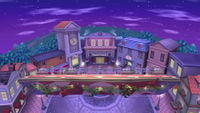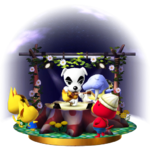Town and City: Difference between revisions
No edit summary |
FightingAloy (talk | contribs) mNo edit summary |
||
| Line 6: | Line 6: | ||
|caption =[[File:AnimalCrossingSymbol.svg|50px]] | |caption =[[File:AnimalCrossingSymbol.svg|50px]] | ||
|universe = ''{{Uv|Animal Crossing}}''<br/> | |universe = ''{{Uv|Animal Crossing}}''<br/> | ||
|games = ''[[SSB4]]'' ([[SSBU|Wii U]]) | |games = ''[[SSB4]]'' ([[SSBU|Wii U]])<br>''[[Ultimate]]'' | ||
|hometo = {{SSB4|Villager}} | |hometo = {{SSB4|Villager}} | ||
|availability = [[Starter stage|Starter]] | |availability = [[Starter stage|Starter]] | ||
Revision as of 22:49, June 14, 2018
| Town and City | |
|---|---|
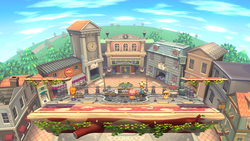 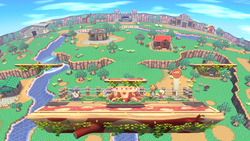 
| |
| Universe | Animal Crossing |
| Appears in | SSB4 (Wii U) Ultimate |
| Availability | Starter |
| Maximum players | 8 |
| Tracks available | Plaza / Title (Animal Crossing: City Folk / Animal Crossing: Wild World) Tour (Animal Crossing: New Leaf) Kapp'n's Song Outdoors at 7 p.m. (Sunny) / Main Street Bubblegum K.K. K.K. Slider tracks: K.K. Cruisin' K.K. Condor K.K. Western K.K. Gumbo Rockin' K.K. DJ K.K. |
| Articles on Nookipedia | Town City |
Town and City (村と街, Village and City) is a stage in Super Smash Bros. for Wii U. True to its name, the stage's setting alternates between the town and city from Animal Crossing: City Folk.
Stage Layout
The stage is similar in layout to Smashville, the previous Animal Crossing stage. There is a single main platform which has different smaller platforms above it depending on its location. The main platform will travel between town and city background areas. In the town section, three small platforms appear above the main one, appearing over the left, middle, and right of the stage; in the city section, there are only two, appearing over the left and right sides. These platforms all move slightly and fly away when the stage transitions. The stage stays at each background area for about 30 seconds before taking about 15 seconds to transition to the other.
Like Smashville, the stage's lighting and design changes for the daytime, evening, and nighttime. This is determined by the Wii U system's clock. Sometimes, the Roost can be seen in the background of the stage. Also, like in Smashville, K.K. Slider performs music on Saturday nights starting at 8:00 p.m. He appears in the background for the town section of the stage, though the music still continues when the platform is in the city. Like Smashville, background characters pick "favorite" fighters at random and act accordingly depending on their performance on a match.
Background Characters
Like Smashville, Town and City features several background characters. Some characters only appear during certain times of the day.
- Blathers
- Brewster
- Celeste
- Crazy Redd
- Don Resetti
- Dr. Shrunk
- Frillard
- Gracie
- Gulliver
- Harriet
- Joan
- Katie & Kaitlin
- Katrina
- Kicks
- Labelle
- Lloid
- Lyle
- Mabel
- Mr. Resetti
- Pascal
- Pelly
- Phineas
- Phyllis
- Rover
- Sable
- Saharah
- Serena
- Timmy
- Tommy
- Tom Nook
- Tortimer
- Wendell
- Wisp
Ω Form
The main platform is increased in length slightly to match Final Destination, and the smaller moving platforms, balloons, and background characters are gone. The stage still transitions to the town and city.
In competitive play
Town and City is a universally legal stage, either as a starter or counterpick in Smash 4 rulesets, due to its lack of hazards and the only gimmick of the stage being the platform cycling. Despite the stage's size, every blast line is actually slightly closer to the stage in comparison to Smash 4's other legal stages, and the first cycle of soft platforms includes a middle platform that shifts vertically, which makes it a good stage for characters with strong vertical finishers, such as Ryu and Meta Knight. The second cycle of soft platforms can also facilitate earlier KOs, since they can move closer to the side blast lines, and both transitions can be used as a last ditch effort for a Sacrificial KO if a grab is landed. The stage is still legal despite the fatal moving platforms.
Origin
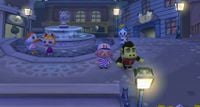
This stage originates from Animal Crossing: City Folk (Animal Crossing: Let's Go to the City in the PAL region). The game's most prominent new feature was the ability for the player to take a bus to the city, which is home to various shops, services, and events.
In 2001, a Japanese Nintendo 64 game called Animal Forest was released, which is the first game in the Animal Crossing franchise. Animal Forest was translated, and ported to the GameCube as Animal Crossing (also known as Animal Crossing: Population Growing) with some added features, such as the Able Sisters building and the Museum. As Animal Forest is the first Animal Crossing game, the GameCube version is a remake of the same game.
Each Animal Crossing game takes place in a small town. A typical town can be seen in the town portion of this stage. Here are all the buildings that appear in the background in the town:
| Building | Origin Game | Purpose |
|---|---|---|
| Able Sisters | Animal Crossing | Design patterns for shirts and umbrellas, which the player can then wear or trade. |
| Animal Villager Houses | Animal Crossing (design from City Folk) | Residence of the non-playable villager characters. |
| Fountain | Animal Crossing: City Folk | Appears in front of the gate after the second town fund is completed. |
| Museum | Animal Crossing | Where the player can donate their bugs, fish, paintings, and fossils that they caught for viewing. |
| Nook's Cranny | Animal Crossing (design from Wild World and City Folk) | The first incarnation of Tom Nook's store where purchases of a small variety of items can be made. |
| Player's House | Animal Crossing (design from City Folk) | Residence of the player who can buy furniture, wallpaper, and floor designs for the interior. |
| Town Gate | Animal Crossing: City Folk (Castle style) | Allows the player to visit another player's town. |
| Town Hall | Animal Crossing: Wild World | Where the player pays off his or her debt to Tom Nook, reports other villagers, send mail etc. |
The town in SSB4 retains almost everything that can be seen in a town in the Animal Crossing series such as trees, rocks, flowers, a river, and bridges,. The bus station in the town can be seen by the Town Gate, and there a bus sign on the same platform as the arena itself. The overall design of the city in SSB4 is also retained. The buildings that can be seen in the background include:
| Building | Purpose |
|---|---|
| Auction House | Where items can be displayed and bid on by the player and their friends via Wi-Fi. |
| GracieGrace | Where expensive furniture, clothes and accessories are sold. |
| Happy Room Academy | Players can check their score here, and it is also where the model room is. |
| The Marquee | A theater where the player can learn emotions. |
Trophy Description
Get a bird's-eye view of the town and city from Animal Crossing: City Folk as you fight on a platform overhead. Your Wii U console's clock dictates the time of day and which animals and places appear. Don't get too distracted by all that, though, because the platform itself is pretty simple-perfect for a battle of skill!
Gallery
Villager using Lloid Rocket in the city.
Toon Link on the stage.
Greninja and Toon Link on the stage in the evening.
Rosalina flat on her back.
Trivia
- Not counting the K.K. Slider songs, Town and City is the only stage in Super Smash Bros. for Wii U whose musical selection is composed entirely of new remixes.
- If a Metal Box is broken on this stage, the metallic texture will always have the daytime reflection, even if the stage is played at night.
Update history
- Added 8-player mode version of the stage and its omega form.
|
| |
|---|---|
| Fighters | Villager (SSB4 · SSBU) · Isabelle (SSBU) |
| Assist Trophies | Mr. Resetti · Isabelle · Kapp'n |
| Stages | Smashville · Tortimer Island · Town and City |
| Items | Pitfall · Beehive |
| Other | K.K. Slider · Lloid · Timmy & Tommy · Tom Nook |
| Trophies, Stickers and Spirits | Trophies (SSBB · SSB4) · Stickers · Spirits |
| Music | Brawl · SSB4 · Ultimate |
